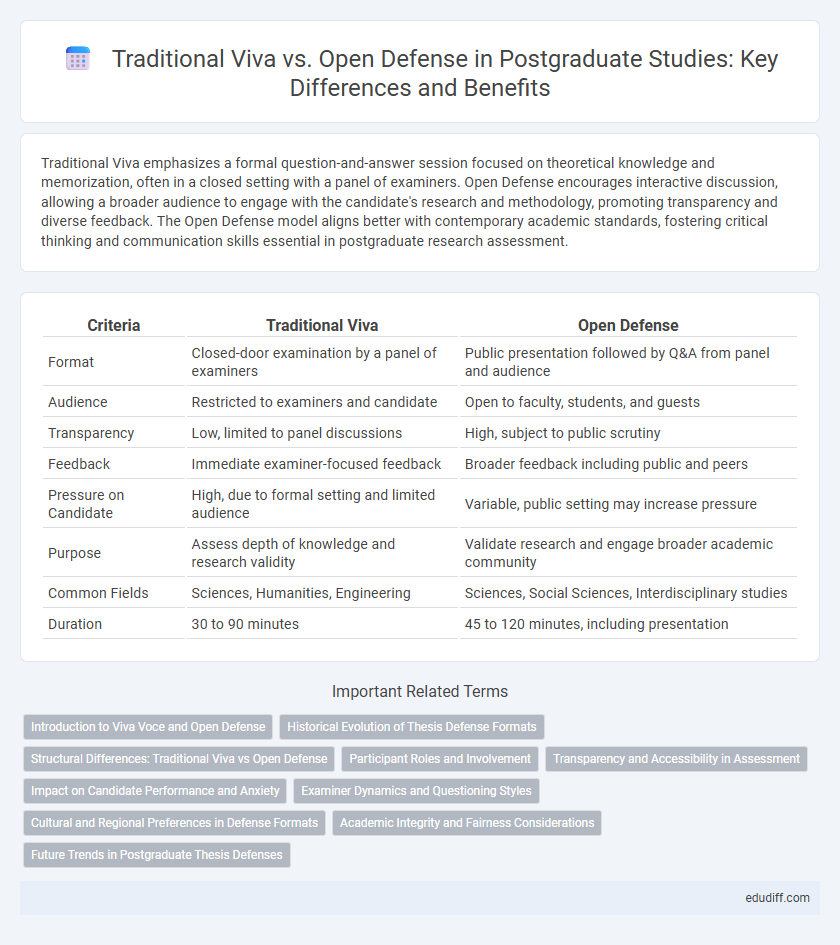Traditional Viva emphasizes a formal question-and-answer session focused on theoretical knowledge and memorization, often in a closed setting with a panel of examiners. Open Defense encourages interactive discussion, allowing a broader audience to engage with the candidate's research and methodology, promoting transparency and diverse feedback. The Open Defense model aligns better with contemporary academic standards, fostering critical thinking and communication skills essential in postgraduate research assessment.
Table of Comparison
| Criteria | Traditional Viva | Open Defense |
|---|---|---|
| Format | Closed-door examination by a panel of examiners | Public presentation followed by Q&A from panel and audience |
| Audience | Restricted to examiners and candidate | Open to faculty, students, and guests |
| Transparency | Low, limited to panel discussions | High, subject to public scrutiny |
| Feedback | Immediate examiner-focused feedback | Broader feedback including public and peers |
| Pressure on Candidate | High, due to formal setting and limited audience | Variable, public setting may increase pressure |
| Purpose | Assess depth of knowledge and research validity | Validate research and engage broader academic community |
| Common Fields | Sciences, Humanities, Engineering | Sciences, Social Sciences, Interdisciplinary studies |
| Duration | 30 to 90 minutes | 45 to 120 minutes, including presentation |
Introduction to Viva Voce and Open Defense
Viva Voce is a traditional oral examination where postgraduate students defend their thesis before a panel of experts, emphasizing in-depth questioning and critical engagement with research findings. Open Defense extends this format by inviting a broader audience, including peers and external academics, to participate and observe the presentation and defense, promoting transparency and academic discourse. Both methods assess the candidate's knowledge and research rigor but differ in format and level of public involvement.
Historical Evolution of Thesis Defense Formats
Thesis defense formats have evolved from traditional viva voce, which emphasized oral examination in a formal setting, to open defenses that encourage broader academic participation and transparency. The traditional viva originated in European universities as a rigorous verbal interrogation by a closed panel, aimed at assessing in-depth subject knowledge. Modern open defenses incorporate audience engagement and interdisciplinary feedback, reflecting shifts towards collaborative knowledge validation in postgraduate education.
Structural Differences: Traditional Viva vs Open Defense
Traditional viva typically involves a closed, formal examination conducted by a small panel of internal examiners, focusing on detailed questioning of the candidate's thesis or dissertation, whereas an open defense allows a broader academic audience, including external members, to observe and participate in the discussion. The structure of the traditional viva is more rigid, with strict time limits and predetermined questioning, while open defenses often incorporate presentations followed by interactive sessions encouraging wider academic engagement. These structural differences influence the level of transparency, feedback breadth, and public scholarly exchange during the evaluation process.
Participant Roles and Involvement
Traditional viva involves a limited panel of examiners who engage directly with the postgraduate candidate through structured questioning, emphasizing individual performance and subject mastery. Open defense expands participant roles by including a broader audience such as faculty members, peers, and sometimes external experts, fostering a collaborative and transparent evaluative environment. Candidate involvement in open defense extends beyond answering to presenting and defending research findings publicly, enhancing critical dialogue and interdisciplinary feedback.
Transparency and Accessibility in Assessment
Traditional viva examinations often limit transparency due to their closed, one-on-one format between the candidate and examiners, restricting the audience and feedback visibility. Open defenses enhance assessment transparency by allowing broader academic community participation, increasing accountability and providing diverse perspectives during the evaluation process. Accessibility improves in open defenses as they can be attended physically or streamed online, facilitating wider access for remote examiners and observers.
Impact on Candidate Performance and Anxiety
Traditional viva exams often induce heightened anxiety in postgraduate candidates due to the unpredictable questioning and formal setting, potentially impairing performance. Open defenses, by incorporating a broader audience and allowing more structured presentations, tend to reduce stress and facilitate clearer communication of research findings. Studies show that candidates in open defenses generally exhibit greater confidence and improved critical thinking skills, positively impacting overall assessment outcomes.
Examiner Dynamics and Questioning Styles
Traditional Viva exams involve a formal setting where examiners pose precise, often rigid questions to assess specific knowledge areas, emphasizing individual expertise. Open Defense formats foster a more interactive dialogue, encouraging examiners to explore broader research implications and engage in dynamic questioning that adapts to candidate responses. Examiner dynamics in Traditional Viva lean towards interrogation, while Open Defense promotes collaborative inquiry, impacting the depth and flexibility of assessment.
Cultural and Regional Preferences in Defense Formats
Traditional Viva exams are prevalent in Commonwealth countries like India and the UK, emphasizing oral questioning by a panel of experts, reflecting local academic customs. Open Defense formats dominate in the United States and European universities, encouraging public presentation and peer participation to enhance academic transparency. Regional preferences in defense formats often align with educational values and cultural norms, influencing how postgraduate candidates prepare and engage in their final evaluations.
Academic Integrity and Fairness Considerations
Traditional Viva examinations often rely on direct questioning by a closed panel, which may limit the diversity of perspectives but ensures a controlled academic environment emphasizing integrity. Open Defense formats promote transparency and collegial scrutiny by allowing a wider audience, potentially enhancing fairness through broader academic engagement and accountability. Both approaches require robust guidelines to uphold academic integrity and equitable assessment standards in postgraduate evaluations.
Future Trends in Postgraduate Thesis Defenses
Future trends in postgraduate thesis defenses indicate a shift from traditional viva formats towards open defense models that enhance transparency and interdisciplinary dialogue. The integration of digital platforms and virtual reality tools is expected to facilitate wider audience participation and real-time feedback, transforming assessment dynamics. Emphasis on collaborative evaluation and public engagement aligns with evolving academic standards and the demand for greater research accessibility.
Traditional Viva vs Open Defense Infographic

 edudiff.com
edudiff.com